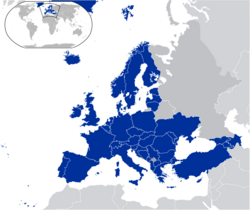Council of Europe Conseil de l'Europe | |
|---|---|
 | |
| Headquarters | Palace of Europe, Strasbourg, France |
| Official languages | English, French[1] |
| Type | Regional intergovernmental organisation |
| Membership |
|
| Leaders | |
| Alain Berset | |
• Deputy Secretary General | Bjørn Berge |
• President of the Parliamentary Assembly | Theodoros Roussopoulos |
• President of the Committee of Ministers | Xavier Bettel |
• President of the Congress of Local and Regional Authorities | Marc Cools |
| Legislature | Parliamentary Assembly |
| Establishment | |
| 5 May 1949 | |
Website coe.int | |
The Council of Europe (CoE; French: Conseil de l'Europe, CdE) is an international organisation with the goal of upholding human rights, democracy and the rule of law in Europe.[2] Founded in 1949, it is Europe's oldest intergovernmental organisation, representing 46 member states,[b] with a population of approximately 675 million as of 2023[update]; it operates with an annual budget of approximately 500 million euros.[3]
The organisation is distinct from the European Union (EU), although people sometimes confuse the two organisations – partly because the EU has adopted the original European flag, designed for the Council of Europe in 1955,[4] as well as the European anthem.[5] No country has ever joined the EU without first belonging to the Council of Europe.[6] The Council of Europe is an official United Nations observer.[7]
Unlike the EU, the Council of Europe cannot make binding laws; however, the council has produced a number of international treaties, including the Convention for the Protection of Human Rights and Fundamental Freedoms (European Convention on Human Rights, ECHR) of 1953. Provisions from the convention are incorporated in domestic law in many participating countries.[8] The best-known body of the Council of Europe is the European Court of Human Rights, which rules on alleged violations of the ECHR.[9]
The council's two statutory bodies are the Committee of Ministers, which comprises the foreign ministers of each member state, and the Parliamentary Assembly of the Council of Europe (PACE), which is composed of members of the national parliaments of each member state.[10] The Commissioner for Human Rights is an institution within the Council of Europe, mandated to promote awareness of and respect for human rights within the member states. The secretary general presides over the secretariat of the organisation. Other major CoE bodies include the European Directorate for the Quality of Medicines & HealthCare (EDQM)[11] and the European Audiovisual Observatory.
The headquarters of the Council of Europe, as well as its Court of Human Rights, are situated in Strasbourg, France. The Council uses English and French as its two official languages. The Committee of Ministers, the PACE, and the Congress of the Council of Europe also use German and Italian for some of their work.[12]
- ^ "Did you know?". Retrieved 1 November 2022.
English and French are the official languages of the Council of Europe.
- ^ "Profile: The Council of Europe". BBC News. Archived from the original on 27 October 2022.
- ^ Council of Europe, Budget, Retrieved: 21 April 2016
- ^ "The European flag – The Council of Europe in brief". The Council of Europe. Archived from the original on 20 December 2022. Retrieved 30 December 2022.
- ^ "The European anthem – The Council of Europe in brief". The Council of Europe. Archived from the original on 4 November 2022. Retrieved 30 December 2022.
- ^ "Do not get confused – The Council of Europe in brief". The Council of Europe. Retrieved 30 December 2022.
- ^ "Intergovernmental Organizations". United Nations. Archived from the original on 2 December 2018.
- ^ Spano, Robert (19 May 2018). "The Future of the European Court of Human Rights—Subsidiarity, Process-Based Review and the Rule of Law". Human Rights Law Review. 18 (3). Oxford University Press: 473–494. doi:10.1093/hrlr/ngy015.
- ^ "The European Court of Human Rights – Council of Europe Office in Georgia – publi.coe.int". Council of Europe Office in Georgia. Retrieved 12 February 2023.
- ^ "Structure – The Council of Europe in brief – publi.coe.int". The Council of Europe in brief. Retrieved 12 February 2023.
- ^ "European Directorate for the Quality of Medicines and Healthcare – European Directorate for the Quality of Medicines & HealthCare – EDQM". European Directorate for the Quality of Medicines & HealthCare. Retrieved 12 February 2023.
- ^ "Headquarters and offices – The Council of Europe in brief – publi.coe.int". The Council of Europe in brief. Retrieved 12 February 2023.
Cite error: There are <ref group=lower-alpha> tags or {{efn}} templates on this page, but the references will not show without a {{reflist|group=lower-alpha}} template or {{notelist}} template (see the help page).

